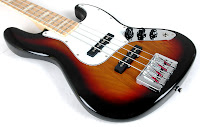Once again, The Audio Mixing Bootcamp was specifically designed for beginning mixers, or musicians with home studios who just can't make their mixes sound right. It's filled with exercises that guide you throughout the process to help you develop both your ear and your mixes. If you're more advanced, the Mixing Engineer's Handbook is the one for you.
Here's the exercise for EQing the bass.
-------------------
"The bass provides the power to the mix, but it’s the relationship between it and drums that really makes a mix sound big and fat. That’s why some mixers will spend hours just trying to fine tune this balance, because if the relationship isn’t correct, then the song will just never sound big and punchy.
At its simplest, EQing the bass at a higher frequency (like 100Hz) and the kick at a lower one (like 60 or 80Hz) or vice-verse can work, however it’s usually a matter of using the frequency juggling method of EQing to find the frequencies that work the best.
The most common frequencies for bass guitar are anywhere from 50 to 100Hz for bottom, attack at 700Hz, and finger snap at 2.5kHz.
Exercise Pod - EQing The Bass
E7.8: A) Solo the bass and drums and raise the monitor level so it’s a little louder than what you’d usually listen at. Can you hear the bass well? Does it mask the kick? Can you hear each note distinctly?
B) Solo the kick and the bass. Can you hear the bass well? Does it mask the kick? Can you hear each note distinctly? Does the bass mask the kick?
C) Wherever you cut a frequency on the kick, boost that frequency on the bass. In other words, if you cut at 400Hz, boost the bass by 2 dB increments in this spot. Can you hear the bass and kick distinctly? Do they reinforce one another?
D) If the kick is boosted at 80Hz, boost the bass at 100 or 120Hz. Can you hear the bass and kick distinctly? Do they reinforce one another?
E) What happens if you switch these frequencies? In other words, if you boost the kick at 100 and the bass at 80Hz. Can you hear the bass and kick distinctly? Do they reinforce one another?
F) Does it sound fuller if you add 2 dB at 60Hz? Does it sound muddy? Does it mask the kick?
G) Insert the high pass filter and set it to 60Hz. Is the bass more distinct? What happens if you move the frequency to 80Hz?
H) Does the bass fit better with the kick if you boost it around 700Hz? Does it fit better if you add 2 dB at around 2.5kHz? Is it more distinct sounding?
I) Add the rest of the drum kit. Can you hear the bass distinctly? Does it mask any other drum? Does it reinforce the kick drum? If so, check where the offending drum is EQed. Cut the frequency on the bass wherever it’s boosted on the clashing drum and boost wherever it’s cut.
J) If the bass still isn’t heard distinctly, make sure that it’s not boosted at the same frequency as any of the drums."
To read additional excerpts from The Audio Mixing Bootcamp and my other books, go to bobbyowsinski.com. You can also find a complete video tutorial based on the book at Lynda.com. Here's a link to a free 7 day trial.
----------------------------------
You should follow me on Twitter for daily news and updates on production and the music business.
Don't forget to check out my Music 3.0 blog for tips and tricks on navigating social media and the new music business.



2 comments:
Amazon states that your bootcamp book is out of stock?
I'm told that it should be back in stock in a day or so.
Post a Comment